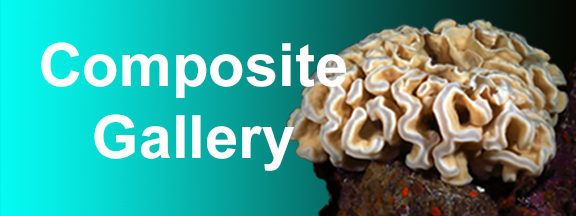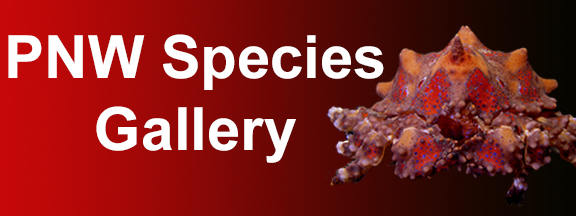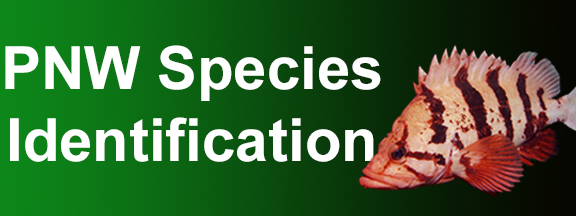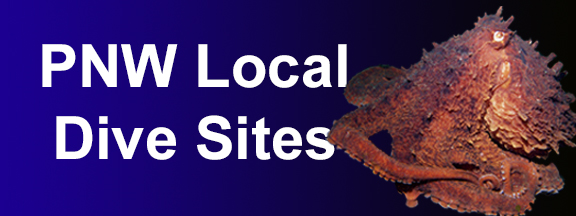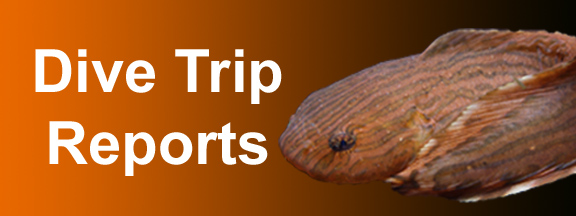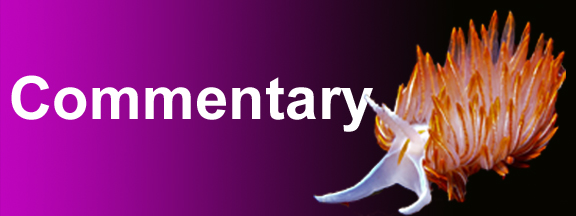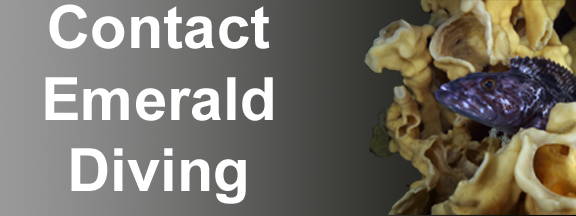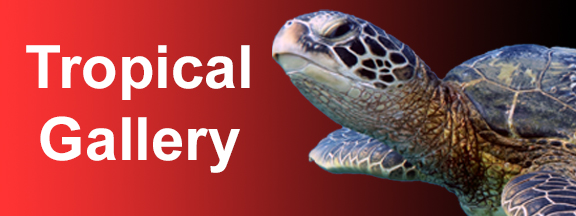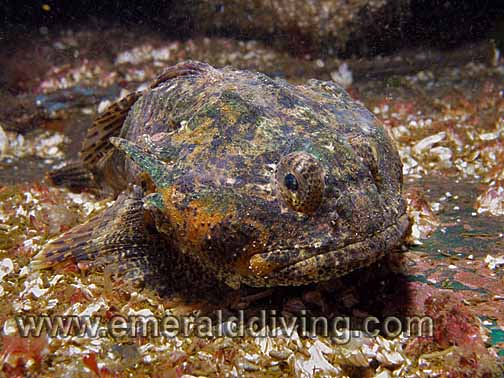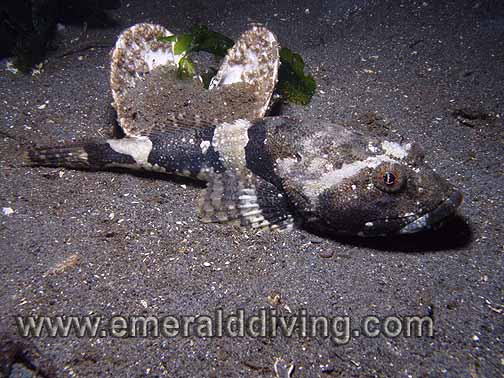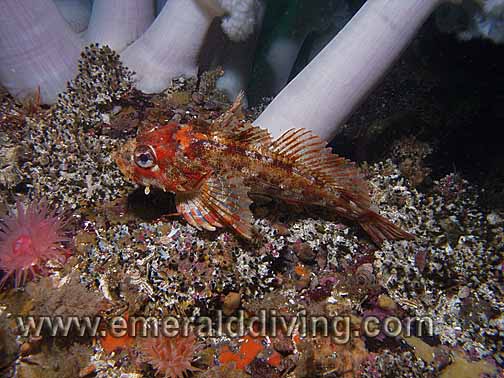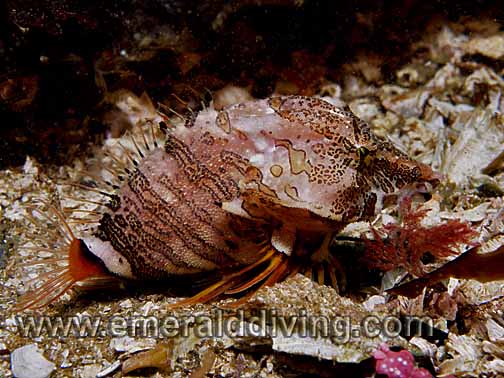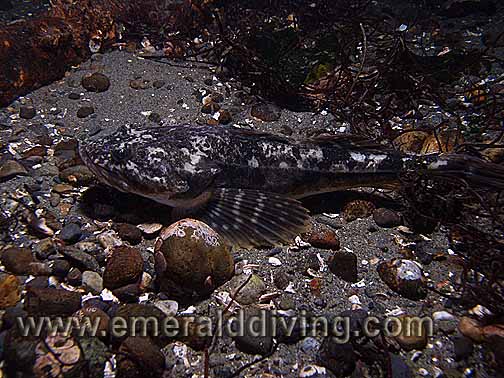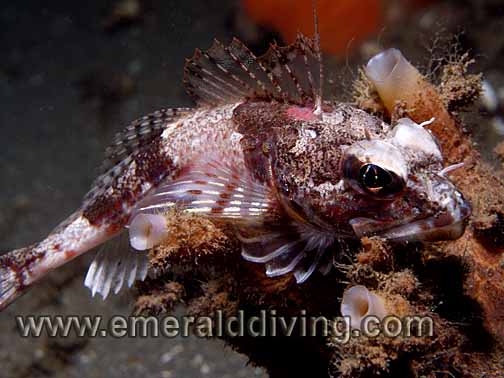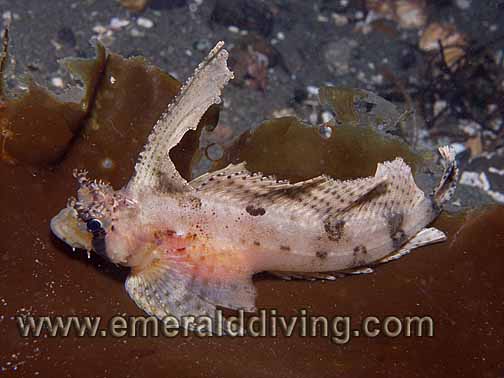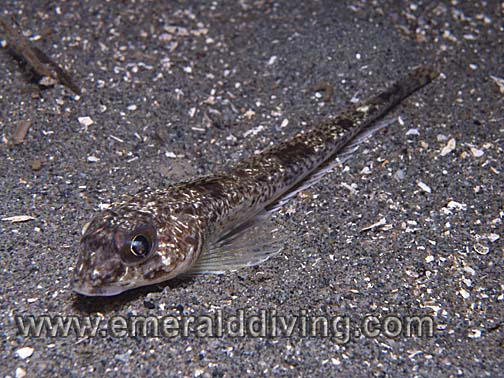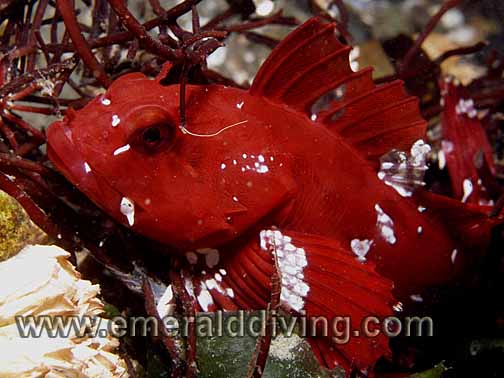

The enlargement viewer only works properly once ALL images on this page are loaded.
Buffalo Sculpin
Enophrys bison
Typical Size: 10-14 length
Distinctive markings: Very large, rounded head with small eyes. Long horns that tuck in on either side of head. Mottled body color can vary and includes browns, whites, yellows, greens, and pinks.
Comments: I always find this bullheaded ambush predator resting on the reef. The buffalo sculpin has limited capability to change its color and shading to best match its surroundings. This sculpin remains motionless when approached by a diver.
Enophrys bison
Typical Size: 10-14 length
Distinctive markings: Very large, rounded head with small eyes. Long horns that tuck in on either side of head. Mottled body color can vary and includes browns, whites, yellows, greens, and pinks.
Comments: I always find this bullheaded ambush predator resting on the reef. The buffalo sculpin has limited capability to change its color and shading to best match its surroundings. This sculpin remains motionless when approached by a diver.
Cabezon
Scorpaenichthys marmoratus
Typical Size: 20-30 length
ID: Large size with disproportionately large head. Large mouth and pelvic fins. Marbled brown and white pattern. Juveniles are typically a brilliant red color.
Comment: The cabezon is the undisputed king of the Northwest sculpins. Females lay large purple egg masses in winter that males ferociously defend. I have been unsuspectingly attacked by nest-guarding males on several occasions at Edmonds. Cabezon are infrequent encountered as they have been over-hunted.
Scorpaenichthys marmoratus
Typical Size: 20-30 length
ID: Large size with disproportionately large head. Large mouth and pelvic fins. Marbled brown and white pattern. Juveniles are typically a brilliant red color.
Comment: The cabezon is the undisputed king of the Northwest sculpins. Females lay large purple egg masses in winter that males ferociously defend. I have been unsuspectingly attacked by nest-guarding males on several occasions at Edmonds. Cabezon are infrequent encountered as they have been over-hunted.
Great Sculpin
Myoxocephalus polyacanthocephalus
Typical Size: 14-20 length
ID: Blotchy brown, black, and/or grey coloration, large head.
Comments: Like most sculpins, the great sculpin is an ambush predator that will lie motionless when approached. This sculpin also has limited capabaility to change its color and shading to match its environment. I only occasionally note this species of sculpin in reef areas throughout Puget Sound.
Myoxocephalus polyacanthocephalus
Typical Size: 14-20 length
ID: Blotchy brown, black, and/or grey coloration, large head.
Comments: Like most sculpins, the great sculpin is an ambush predator that will lie motionless when approached. This sculpin also has limited capabaility to change its color and shading to match its environment. I only occasionally note this species of sculpin in reef areas throughout Puget Sound.
Grunt Sculpin
Rhamphocottus richardsonii
Typical Size: 2-3 length
ID: Long, narrow snout, orange pectoral fins and band on tail. Uniquely shaped body.
Comments: The amazing grunt sculpin is benthic in nature and a favorite photography subject of Northwest divers. I find this cute little fish in small nooks and crannies at the base of reefs, or in discarded jars or abandoned giant acorn barnacles. The grunt sculpin often walks or hops along the bottom on its pectoral fins as it is not the most proficient swimmer.
Rhamphocottus richardsonii
Typical Size: 2-3 length
ID: Long, narrow snout, orange pectoral fins and band on tail. Uniquely shaped body.
Comments: The amazing grunt sculpin is benthic in nature and a favorite photography subject of Northwest divers. I find this cute little fish in small nooks and crannies at the base of reefs, or in discarded jars or abandoned giant acorn barnacles. The grunt sculpin often walks or hops along the bottom on its pectoral fins as it is not the most proficient swimmer.
Longfin Sculpin
Jordania zonope
Typical Size: 2-6 length
ID: Long, narrow body. Intricate orange and blue coloration.
Comments: With an orange and blue body, it is hard to imagine that the longfin sculpin as a master of camouflage, but it is. This slender sculpin is found throughout all Washington waters on rocky structure. However, it is usually not noted unless it moves as it blends in amongst the colorful invertebrates living on the reef. Longfin sculpins are very skittish. ands.
Jordania zonope
Typical Size: 2-6 length
ID: Long, narrow body. Intricate orange and blue coloration.
Comments: With an orange and blue body, it is hard to imagine that the longfin sculpin as a master of camouflage, but it is. This slender sculpin is found throughout all Washington waters on rocky structure. However, it is usually not noted unless it moves as it blends in amongst the colorful invertebrates living on the reef. Longfin sculpins are very skittish. ands.
Red Irish Lord
Hemilepidotus hemilepidotus
Typical Size: 10-18 length
ID: Large eyes with speckles on lens. Color and pattern can change to match the surrounding area. Colors include browns, whites, yellows, reds, purples, and/or oranges.
Comments: This ambush predator has amazing range with its abilty to change color and shading to match its surroundings. The colorful red Irish lord is another favorite photography subject of Northwest divers as it tends to remain motionless when approached.
Hemilepidotus hemilepidotus
Typical Size: 10-18 length
ID: Large eyes with speckles on lens. Color and pattern can change to match the surrounding area. Colors include browns, whites, yellows, reds, purples, and/or oranges.
Comments: This ambush predator has amazing range with its abilty to change color and shading to match its surroundings. The colorful red Irish lord is another favorite photography subject of Northwest divers as it tends to remain motionless when approached.
Pacific Staghorn Sculpin
Leptocottus armatus
Typical Size: 6-10 length
ID: Greenish-brown blotchy topside. Dark green and yellow banded pectoral fins. White underside. Distinctive black spot on dorsal. Two short flat horns on the side of the head.
Comments: Another or the sculpins that prefers to lay in wiat to ambush its prey. The Pacific staghorn sculpin often buries itself in the sand for cover. These sculpins are very agressive and often strike anything they can get their large mouth around.
Leptocottus armatus
Typical Size: 6-10 length
ID: Greenish-brown blotchy topside. Dark green and yellow banded pectoral fins. White underside. Distinctive black spot on dorsal. Two short flat horns on the side of the head.
Comments: Another or the sculpins that prefers to lay in wiat to ambush its prey. The Pacific staghorn sculpin often buries itself in the sand for cover. These sculpins are very agressive and often strike anything they can get their large mouth around.
Roughback Sculpin
Chitonotus pugetensis
Typical Size: 6-9 length
ID: Large eyes. White/cream and brown bands often with some red markings on the fins and body.
Comments: This species appears to be predominately noctural as I only note it on night dives. The roughback is another ambush predator and will ramain perfectly motionless as a diver approaches. This species seem to prefer soft substrates around reefs.
Chitonotus pugetensis
Typical Size: 6-9 length
ID: Large eyes. White/cream and brown bands often with some red markings on the fins and body.
Comments: This species appears to be predominately noctural as I only note it on night dives. The roughback is another ambush predator and will ramain perfectly motionless as a diver approaches. This species seem to prefer soft substrates around reefs.
Sailfin Sculpin
Nautichthys oculofasciatus
Typical Size: 6-10 length
ID: Distinctive oversized first spine of the dorsal. Black band on face through eye.
Comments: I only occasionally note the distinctive sailfin sculpin deep in cracks or under ledges when diving during the day. At night I often encounter sailfin sculpins in the open at Three Tree Point. I believe females tend to be larger than the males and often have an orange belly, as does the sailfin pictured here. Sailfins often undulate their long dorsal fin when they swim
Nautichthys oculofasciatus
Typical Size: 6-10 length
ID: Distinctive oversized first spine of the dorsal. Black band on face through eye.
Comments: I only occasionally note the distinctive sailfin sculpin deep in cracks or under ledges when diving during the day. At night I often encounter sailfin sculpins in the open at Three Tree Point. I believe females tend to be larger than the males and often have an orange belly, as does the sailfin pictured here. Sailfins often undulate their long dorsal fin when they swim
Scalyhead Sculpin
Artedius harringtoni
Typical Size: 2-4 length
ID: Large pectoral fins, orange colored gills. Females have spots on first dorsal. Mature males have two pair of bushy cirri on head.
Comments: The scalyhead sculpin is a common companion when diving Washington waters. However, it is easily mistaken for one of the many other small sculpin species that frequent our area. Note the orange color at the base of the gills which distinguishes the fish in this picture as a scalyhead sculpin.
Artedius harringtoni
Typical Size: 2-4 length
ID: Large pectoral fins, orange colored gills. Females have spots on first dorsal. Mature males have two pair of bushy cirri on head.
Comments: The scalyhead sculpin is a common companion when diving Washington waters. However, it is easily mistaken for one of the many other small sculpin species that frequent our area. Note the orange color at the base of the gills which distinguishes the fish in this picture as a scalyhead sculpin.
Slim Sculpin
Radulinus asprellus
Typical Size: 4-6 length
ID: Dorsal starts about even with pectoral fins. Row of "rougher" scales down each side.
Comments: The slim sculpin is a rare encounter at best. I have only noted this species once on a night dive at Three Tree Point. I have only heard of one other report (in Hood Canal) of a slim sculpin spotting. This sculpin is an ambush predator. As you can see from this picture, it blends in well with a sandy substrate.
Radulinus asprellus
Typical Size: 4-6 length
ID: Dorsal starts about even with pectoral fins. Row of "rougher" scales down each side.
Comments: The slim sculpin is a rare encounter at best. I have only noted this species once on a night dive at Three Tree Point. I have only heard of one other report (in Hood Canal) of a slim sculpin spotting. This sculpin is an ambush predator. As you can see from this picture, it blends in well with a sandy substrate.
Spotfin Sculpin
Icelinus tenuis
Typical Size: 4-5 length
ID: Long, wispy first ray of dorsal fin. Large distinctive black spot on dorsal.
Comments: I have only noted the elusive spotfin sculpin in Hood Canal at Flagpole Point, although I have heard of one other spotfin sighting at another dive sites in Hood Canal. The two spotfin sculpins in this photograph appeared to be involved in a mating ritual and were oblivious to my presence. Love is in the air...or water.
Icelinus tenuis
Typical Size: 4-5 length
ID: Long, wispy first ray of dorsal fin. Large distinctive black spot on dorsal.
Comments: I have only noted the elusive spotfin sculpin in Hood Canal at Flagpole Point, although I have heard of one other spotfin sighting at another dive sites in Hood Canal. The two spotfin sculpins in this photograph appeared to be involved in a mating ritual and were oblivious to my presence. Love is in the air...or water.
Cabezon - Juvenile
Scorpaenichthys marmoratus
Typical Size: 8-14 length
ID: Distincitve bright red color with white markings. Large cirri over eyes.
Comment: I rarely note the spectacularly colored fish. When i am lucky enough to find a juvenile cabezon, it is ususally situated on a soft kelp-covered substrate near a reef .
Scorpaenichthys marmoratus
Typical Size: 8-14 length
ID: Distincitve bright red color with white markings. Large cirri over eyes.
Comment: I rarely note the spectacularly colored fish. When i am lucky enough to find a juvenile cabezon, it is ususally situated on a soft kelp-covered substrate near a reef .
Sailfin Sculpin Juvenile
Nautichthys oculofasciatus
Typical Size: 1-2 length
ID: Distinctive oversized first spine of the dorsal. Black band on face through eye.
Comments: I note the adorable juvenile sailfin sculpin when night diving shallow broadleaf kelp. Note that the dorsal mast if more ornate than that of the adult.
Nautichthys oculofasciatus
Typical Size: 1-2 length
ID: Distinctive oversized first spine of the dorsal. Black band on face through eye.
Comments: I note the adorable juvenile sailfin sculpin when night diving shallow broadleaf kelp. Note that the dorsal mast if more ornate than that of the adult.
Silverspotted Sculpin
Blepsias cirrhosus
Typical Size: 2-4 length
ID: Narrow first dorsal. Wide second dorsal. Long, slender body. Brown to grey coloration. Adults have a row of silver spots on the sides.
Comments: Almost all my silverspotted sculpin sightings are in the eelgrass beds at Sekiu, where they really thrive. This is a terrible picture, but it is difficult to shoot this fish as it likes to coast from eelgrass blade to eelgrass blade when approached. A three foot swell didn't help either. Juvenile pictured in 15 fsw.
Blepsias cirrhosus
Typical Size: 2-4 length
ID: Narrow first dorsal. Wide second dorsal. Long, slender body. Brown to grey coloration. Adults have a row of silver spots on the sides.
Comments: Almost all my silverspotted sculpin sightings are in the eelgrass beds at Sekiu, where they really thrive. This is a terrible picture, but it is difficult to shoot this fish as it likes to coast from eelgrass blade to eelgrass blade when approached. A three foot swell didn't help either. Juvenile pictured in 15 fsw.
Padded Sculpin
Artedius fenestralis
Typical Size: 4-5 length
ID: No "hairs" or cirri on head. High forehead. Unusual meshing of scales and skin below second dorsal.
Comments: Another of the small sculpins that all look the same. However, this common sculpin is a bit easier to discern as it has a blunt snout and no distinguishing features on its head, other than nostrils. Color and pattern vary greatly. Photo taken at Three Tree Point in 10 feet of water.
Artedius fenestralis
Typical Size: 4-5 length
ID: No "hairs" or cirri on head. High forehead. Unusual meshing of scales and skin below second dorsal.
Comments: Another of the small sculpins that all look the same. However, this common sculpin is a bit easier to discern as it has a blunt snout and no distinguishing features on its head, other than nostrils. Color and pattern vary greatly. Photo taken at Three Tree Point in 10 feet of water.
Snubnose Sculpin
Orthonopias triacis
Typical Size: 2-3 length
ID: Short, stubby nose. Anus located closer to the pelvic fins rather then the anal fin.
Comments: This species was reported to venture no farther north than the Farralon Island in California. However, Andy Lambe found multiple specimens of Solaster Island off Brooks Peninsula on the west side of Vancouver Island during our dive trip - effectively extending the range of this little scuplin by thousands of miles.
Orthonopias triacis
Typical Size: 2-3 length
ID: Short, stubby nose. Anus located closer to the pelvic fins rather then the anal fin.
Comments: This species was reported to venture no farther north than the Farralon Island in California. However, Andy Lambe found multiple specimens of Solaster Island off Brooks Peninsula on the west side of Vancouver Island during our dive trip - effectively extending the range of this little scuplin by thousands of miles.


